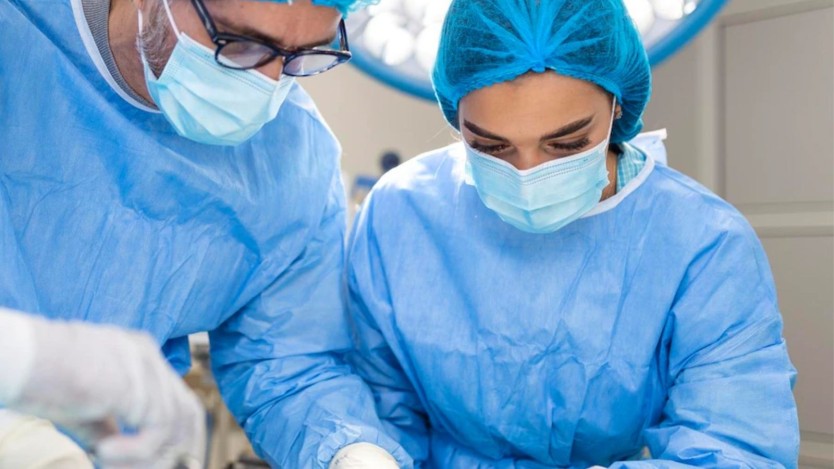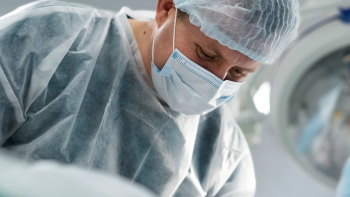Inguinal Hernia: What is it, Causes, Types, Symptoms and Treatment

- What is an inguinal hernia?
- Causes
- Types
- Symptoms
- Treatment
- Bibliography
- Source information
- Frequent Questions
Inguinal hernia is a type of hernia that occurs in the groyne and involves a loop of intestine exiting through a weakened area of the abdominal cavity, known as the fascia. This condition presents as a bulge in the groyne area which, in men, may extend into the scrotum.

Do you need inguinal hernia surgery?
Request a free and immediate appointment with our specialists
Hernia is usually accompanied by pain and discomfort, although it is possible that they may be asymptomatic, especially in the early stages.
There is a higher incidence in adult men, but it also occurs in women, even in newborn children, due to a congenital defect.

Although preventive measures are available, the only definitive treatment is surgical intervention, known as herniorrhaphy.
- Inguinal hernia is a protrusion of part of the intestine through a weak area of the abdominal cavity, known as the fascia.
- Inguinal hernia can be acquired, developing over time, or congenital, due to a birth defect.
- The only definitive treatment for inguinal hernia is surgery.
What is an inguinal hernia?
An inguinal hernia is the protrusion of part of the intestine, or another abdominal organ, through a hole in the abdominal wall, extending into the groyne.
This type of inguinal protrusion is more common in men, due to the anatomy of the groyne area, developing in the groyne and can extend down to the scrotum. In the case of women, the hernias that occur in this area are crural hernias.
The abdomen contains viscera covered by a layer of peritoneum. These viscera press the abdominal wall outwards, so if any weaker areas (fascia) tear, this can cause the contents to leak outwards.

Thus, inguinal hernia can arise on the right or left side and can be direct or indirect, depending on where it originates.
75% of hernias arise in the inguinal area.
This condition causes a decrease in the amount of blood reaching the intestine.
In fact, one of the complications of inguinal hernia is strangulation due to compression of the tissues, which hinders their vascularisation and can lead to ischaemia and subsequent necrosis. In these cases, surgery is mandatory and urgent. However, the probability of this happening is 0.3% to 2.9%.
On the other hand, some children are born with a genetic predisposition to inguinal hernias. In these cases, we speak of congenital inguinal hernias.
Causes
The causes of inguinal hernia can be congenital in origin or defects acquired over time.
Although there are no specific causes of inguinal hernias, and they can appear at birth and become noticeable over the years, it is true that, in most cases, they are caused by straining or by increased pressure on the muscles of the abdominal wall.

Thus, inguinal hernia can occur as a result of:
- Chronic coughing or sneezing
- Lifting heavy objects
- straining during defecation or chronic constipation
- straining during urination
- Prostatic enlargement
- Nausea and vomiting
- Cystic fibrosis
- Cryptorchidism (undescended testicles).
- Malnutrition
- Overexertion
- Overweight
- Smoking
In addition, some people are at a higher risk of developing an inguinal hernia:
- Men are more likely to develop an inguinal hernia.
- Older people are more at risk as muscles weaken over the years.
- Caucasians
- Patients with a family history of inguinal hernia
- Pregnancy not only weakens the muscles, but also causes increased abdominal pressure.
- Premature birth and/or low birth weight
- Patients with previous hernias, regardless of whether it was in childhood, are more likely to develop another, as are those who have had previous hernia surgery.
Types
Inguinal hernia can be external, if the protrusion is outward and a bulge appears, or internal if it forms in the peritoneum and is not visible on the body surface.

Do you need inguinal hernia repair?
Request a free and immediate appointment with our specialists in general surgery
In addition, there are two types of inguinal hernia, depending on where they originate:
- Direct inguinal hernia: the viscera enter through the abdominal wall which is broken, surround the inguinal canal and go outwards. This type of hernia is always more common in men over 40 years of age, due to ageing or injury.
Direct inguinal hernia is acquired, it is never congenital.
- Indirect inguinal hernia: in this case, the intestinal loop presses against the inguinal canal which, due to a congenital defect, is at greater risk of crossing and developing an inguinal hernia.
- It is therefore a type of congenital hernia, and is as common in men as in women.
Symptoms
An inguinal hernia presents as a bulge in the groyne region that is sometimes accompanied by pain or discomfort that is accentuated by physical exertion.
In addition to this, there are several signs and symptoms that may make you suspect that the bulge in your groyne is an inguinal hernia:
- Lump on the side of the pubic bone (left or right) that becomes larger when you become more upright, cough or strain.
- Pain or discomfort, in the area around the lump, increases if you bend over, cough or lift.
- Feeling of heaviness and/or pressure in the groyne.
- In the case of men, if the inguinal hernia descends into the scrotum, there will be pain and swelling in the testicular area.
In newborn infants, the hernia is sometimes visible when they cry, cough or strain their bowels, but this is not always the case. However, it is common for them to be irritable and less hungry than usual.
In older children, the hernia becomes more noticeable when coughing or during bowel movements. However, it is your doctor who will ultimately confirm that you or your child's lump is due to a hernia.

In some cases, inguinal hernia can present complications, when the contents become trapped (incarcerated hernia). In these cases, the hernia can become strangulated, which would interrupt the blood supply and could be life-threatening.
It is therefore imperative that you see a doctor immediately if you develop symptoms of strangulated hernia:
- Nausea and/or vomiting
- High temperature or fever
- Severe pain
- The hernia bulge changes colour to red, purplish or some dark colour.
- Difficulty emptying the bowel or passing gas
If the hernia has no serious complications, the operation is not very difficult for an experienced general surgeon.

Do you need inguinal hernia surgery?
Request a free and immediate appointment with our specialists
Complications of an inguinal hernia
- Involvement of nearby tissues. In most inguinal hernias that are not treated surgically, the size increases. In men, they may extend into the scrotum, causing testicular pain and swelling.
- Incarcerated hernia. The abdominal contents of the hernia may become trapped in one spot, even obstructing the bowel. In these cases, the most common symptoms are nausea or vomiting, inability to evacuate the bowel or pass gas.
- Strangulated hernia. The incarcerated hernia, mentioned above, can cut off the blood supply to part of the intestine, causing strangulation. This can lead to death of the affected tissues, which can be life-threatening.
Treatment
The definitive treatment for inguinal hernia repair is surgery, known as herniorrhaphy. In fact, it is the only method, after which you will be able to resume your normal activities.
During surgery, the abdominal contents are reintroduced and the weakened part of the tissue that has suffered the tear and prolapsed the abdominal contents is sealed or reinforced.
The inguinal hernia surgery or herniorrhaphy can be performed by open surgery or by the laparoscopic technique. The specialist will recommend one method or the other depending on the size of the hernia, its location, the patient's health and age, the risks involved in the surgical intervention and tolerance to anaesthesia.
Open surgery
Inguinal hernia repair by open surgery may be performed under local, spinal or general anaesthesia.
- First, the specialist makes an incision near the hernia.
- Repair the weak area of the muscle with a suture that will hold abdominal pressure well, or place a mesh to reinforce the weak spot.
- Non-mesh inguinal hernia repair is performed on strangulated or infected hernias, or if it is an infantile hernia.
Laparoscopic surgery
Laparoscopic inguinal hernia surgery is a minimally invasive procedure performed through small incisions:
- The surgeon makes several mini incisions to insert the laparoscope.
- The surgeon then inflates the abdomen to improve the visibility of the internal organs and, in the same way as in open surgery:
- Stitches the tissues together and repairs the weakened area, or…
- The surgeon closes the hole with a mesh and either sutures or staples it in the appropriate position.

Laparoscopic surgery can be performed using the following techniques:
- Transabdominal Peritoneal Technique (TAPP): the abdominal cavity and the hernia defect are accessed from the posterior part, placing the surgical mesh in the preperitoneal space.
- Total Extraperitoneal Surgery (TEP): the mesh is placed between the musculature and the peritoneum, over the rupture point. The anatomical structures fix the mesh, so no additional support is required.
Once the surgery is over, you will need to rest for at least 15 days, during which time you should not exert yourself physically.
This procedure has a very low rate of postoperative complications. In fact, relapse in an inguinal hernia, already operated on, is minimal and less than 5% of cases.
Bibliography
- Góngora-Gómez, E. M. (2012, agosto). La hernia inguinal estrangulada. Recuperado de https://www.medigraphic.com/pdfs/circir/cc-2012/cc124i.pdf
- The American College of Surgeons. (2014, mayo). Hernia: Inguinal/Femoral. Recuperado de https://www.facs.org/~/media/files/education/patient%20ed/herniaespanol.ashx

Do you need surgical repair for an inguinal hernia?
Request a free and immediate appointment with our specialists in general surgery
Dr. Antonio Rebollo Marina
Médico Asistencial en Centro Médico Caser
Nº colegiado: 282834715

Medical disclaimer: All the published content in Operarme is intended to disseminate reliable medical information to the general public, and is reviewed by healthcare professionals. In any case should this information be used to perform a diagnosis, indicate a treatment, or replace the medical assessment of a professional in a face to face consultation. Find more information in the links below:
Frequent Questions
-
¿Cómo puedes detectar una hernia inguinal?
La detección de una hernia inguinal generalmente se basa en la observación de síntomas y una evaluación médica. Algunas formas de detectar una hernia inguinal son:
- Autoexamen
- Acuéstate boca arriba y relaja los músculos de la pared abdominal.
- Coloca tus dedos en el área donde el muslo se encuentra con el abdomen, en busca de un bulto o protuberancia.
- Tose o realiza algún esfuerzo durante el autoexamen, ya que esto puede hacer que la hernia sea más evidente.
- Exámenes médico: en algunos casos, el médico podría ordenar pruebas adicionales, como una ecografía o una tomografía computarizada, para obtener una imagen más detallada de la hernia y su alcance.
- Autoexamen
-
¿Qué es una hernia inguinal y porqué salen?
Una hernia inguinal es una afección en la cual una porción del intestino o de otros tejidos abdominales sobresale a través de una debilidad en la pared muscular del abdomen en la región inguinal. Algunas de las causas más frecuentes por las que se producen son:
- Debilidad en la pared abdominal.
- Realizar esfuerzos físicos constantes.
- Algunas hernias inguinales son congénitas, lo que significa que están presentes desde el nacimiento.
- Leer más
-
¿Qué órganos afecta la hernia inguinal?
Las hernias inguinales generalmente afectan los órganos y tejidos en la región abdominal, en la zona de la ingle. Las principales estructuras involucradas en una hernia inguinal suelen ser el intestino delgado y, en algunos casos, el tejido graso del abdomen. Leer más

